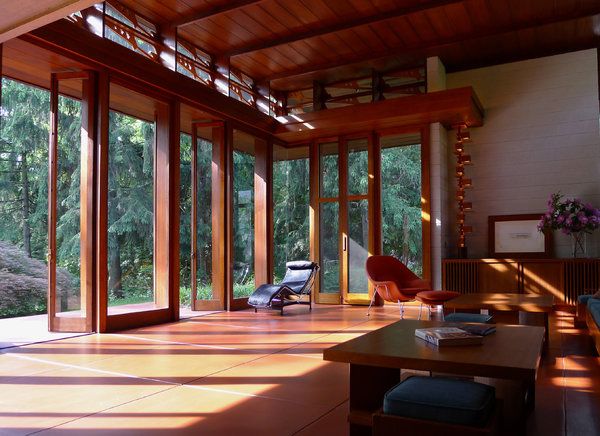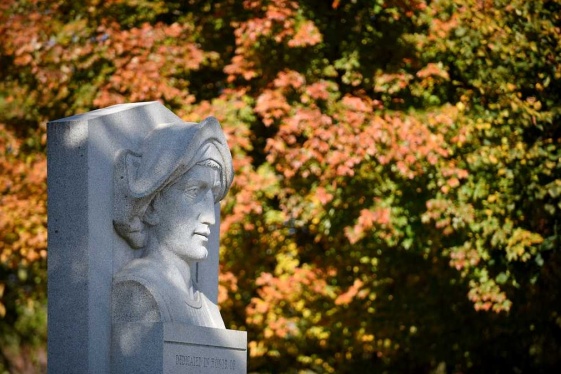
To Move Wright House to Italy, All It Takes Is a Buyer

Paolo Bulletti has a dream. The Italian architect wants to transport a house built by the distinguished U.S. architect Frank Lloyd Wright from its current site in New Jersey to the hills of Fiesole, near Florence.
His "mission impossible," as his wife, Valeria, has dubbed it, was hatched three years ago when he organized an exhibition in Fiesole to celebrate not just the centenary of Wright's birth but also Wright's emotional connection to the area.
Wright lived in the Italian hill town in 1910, after fleeing the United States with his mistress, Mamah Borthwick Cheney, to avoid the scandal surrounding their affair.
Lawrence and Sharon Tarantino, who now own the Wright house in Millstone, New Jersey, heard of the exhibition thanks to press and Internet coverage. They contacted Mr. Bulletti, suggesting that he buy their home and move it to Italy.
"At first I thought the idea was silly, but it was such a cultural challenge that we decided to get together," Mr. Bulletti recalled. "We obviously met in Fiesole and had a lunch under the trees of the piazza. It was summer and immediately we found a lot of mutual interests and shared the same visions. We walked up the hill to the house where Wright spent his time in Fiesole and discussed all the details."
The Tarantinos, who have an architecture firm in New Jersey, have signed an exclusive agreement identifying Mr. Bulletti as the Italian agent "to research buyers for the relocation of their property." As is common with Wright houses, the furnishings would be included.
The residence, known as the Bachman Wilson House, was designed in 1954 for Abraham Wilson and his first wife, Gloria Bachman. It is an example of Wright's "Usonian" style, which aimed to produce moderately priced homes.
The house would be a striking addition to the olive groves and terra cotta roofs of Fiesole. Built of concrete blocks with mahogany trim, it has low, rectilinear lines and one windowless wall that is a sharp contrast to the floor-to-ceiling windows opposite.
When the Tarantinos bought the property in 1988, it was in poor condition and required a substantial renovation. They had to line up buckets to catch the leaks, a common problem with Wright's flat roofs, and scrape off the thick paint that had been applied over the original elegant fittings of Philippine mahogany.
More recently, the house has been threatened by the nearby Millstone River. "The flooding has become worse over the past few years, and we realized that the only alternative to save the house was to move it," Mrs. Tarantino said. "We are pursuing various options, but Italy attracts us the most. My husband and I studied in Genoa 40 years ago, so it is the romantic solution.
"We are optimistic that it will happen," she added.
But what are the chances of raising enough money?
"The cost would be $1.5 million," said Mr. Bulletti, who is a professor at Texas A&M University's College of Architecture program in Castiglion Fiorentino, south of Florence. "That includes the dismantling and shipping in containers to the port of Genoa. We don't know how much it will cost to rebuild until we know if we have companies that might be interested in sponsoring the rebuilding."
Although Mr. Bulletti has yet to find a site, he insists that the mayors of Florence and Fiesole would be more than happy to have the house. "They are waiting to hear from us for evidence of interest in the purchasing by institutions and private individuals," he said. "We have been contacted by businessmen and art lovers and are currently following up with these people."
Mr. Bulletti said the house could not be used as a residence in Fiesole, because it did not meet current planning regulations. "But it can be erected in protected land, a park or a garden as if it were a sculpture," he continued.
Everyone acknowledges that the timing is poor. The economic situation in Italy means public and private funds are in short supply and, with the general election campaign under way, no mayor would lend his name to such an extravagant project.
Nonetheless, Fulvio Irace, a professor of history at Milan Polytechnic, thinks that public institutions in Florence or Fiesole or even Venice should consider buying the house.
"The villa — after surviving the separation of spouses and a continuous exchange of owners — is now in danger," he wrote last June in the financial newspaper Il Sole 24 Ore. "If in times of crisis, we can launch a crazy idea, why doesn't a public authority such as the Venice Biennale buy the house to rebuild it as a pavilion in the Giardini," referring to the park where the Biennale is staged.
by Richard Holledge / New York Times
You may be interested
-
A wreath for Columbus and three crowns for t...
The Columbus Day Committee of Atlantic City along with the Bonnie Blue Foundation annually...
-
Lecture and Concert that bring Italy to New...
Saturday, february 28 - 7 pm ESTChrist & Saint Stephen's Church - 120 W 69th St,...
-
Sons of Italy Wine Tasting Series
Saturday, August 1 - 12.30 EDT / Valenzano Winery - 1090 Route 206, Shamong, New...
-
'A Bronx Tale, the Musical' features Sayrevil...
When “A Bronx Tale, the Musical” opens at the Axelrod Performing Arts Center in Deal on Oc...
-
'Atmosphere of anger' in Glen Rock and beyond...
The debate over turning Columbus Day into Indigenous Peoples’ Day has people riled up on b...
-
'Bad boy' Mike Marino helps disabled girl, Br...
by Pamela MacKenzie He may have some irreverent slants on life and some jokes in...
-
'Buongiorno Papà' vince Nice Festival Usa
'Buongiorno papà' di Edoardo Leo, film sui quarantenni single in Italia, interpretato da R...
-
'Cake Boss'' to open bake shop at the Metropo...
Carlo's Bakery, the Hoboken-based enterprise made famous in the reality TV show "Cake Boss...










